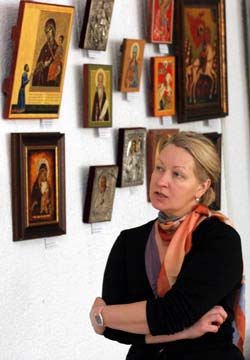The Burning Bush of iconography

An exhibit of works by the pupils of Neopalyma Kupyna (The Burning Bush), Ukraine’s only school of iconography, has opened at Kyiv’s Palace of Children and Youth. The collection comprises over 130 works done by people of different ethnic origins and faiths, aged from 14 to 75.
This is the school’s fifth exhibit in the eight years of its existence, but this year’s show features a large number of original works. The artists combined several techniques in their works, from painting to carving. The organizers of the show claim that their show features all the varieties of iconographic art: the canonical Byzantine style, the ancient Rus’ style, and examples of the Kyiv, Moscow, and Novgorod schools. Every work is unique and reveals the artist’s individuality, soul, and love of icons.
“Among the exhibit’s works is an icon whose embroidered surface is adorned with pearls and precious stones,” said the director of the studio Alla Drohan. “This work proves that our students are constantly making progress. At first they copied the works of great painters, but now they are implementing their own ideas. Our school probably owes its successful development to the icon called ‘The Burning Bush,’ which is a symbol and protective charm for all of us.”
The main goal of the Neopalyma Kupyna studio is to master the various techniques of iconography — the ones we inherited from Kyivan Rus’ artists, as well as modern painting methods.
Drohan told The Day that the students begin working on an icon by choosing a wooden board. First, it should be coated with a special primer. Then comes the creative stage: various paints are applied (including modern-day tempera), mineral pigments, precious or semiprecious stones, which are ground into powder and mixed with a special egg-based solution to prepare a thick mass that serves as a base paint. The duration of creating an icon depends on the artist’s concept and the particularities of the chosen technique. For example, it took some students six months or longer to create some of the exhibited icons.
In the future Neopalyma Kupyna is planning to display icons that were damaged during the war or stored in poor conditions and were then restored by the school’s masters. In all probability, the future exhibit will be called “The Return of the Holy Virgin,” to help people understand that everything has the right to a new lease on life.






